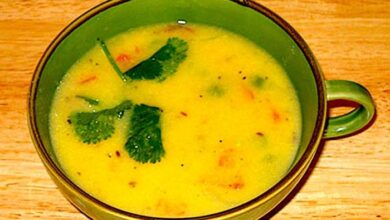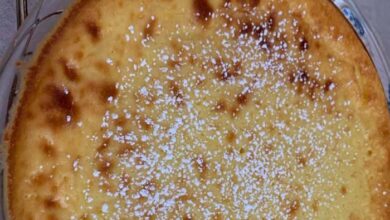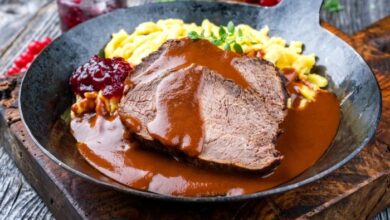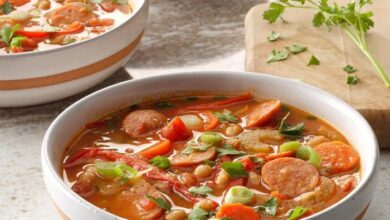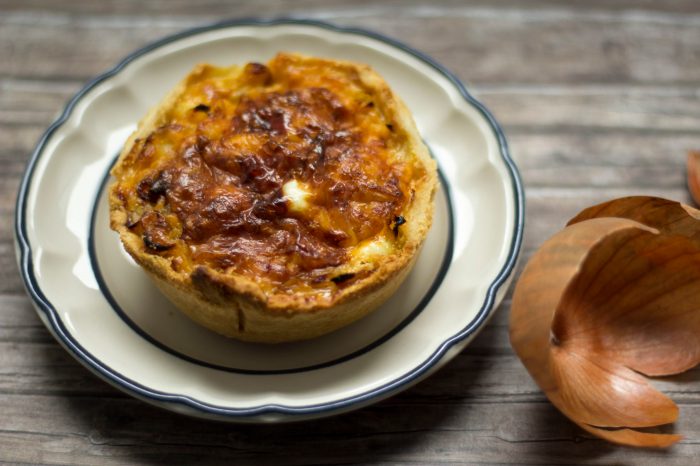
German Zwiebelkuchen Onion Pie: A Taste of German Tradition
German Zwiebelkuchen onion pie takes center stage, a culinary masterpiece that embodies the heart of German tradition. This savory delight, often enjoyed during festive gatherings and cherished family meals, is a testament to the rich history and cultural significance of German cuisine.
Its origins can be traced back centuries, evolving from humble beginnings to become a beloved staple in many German households.
The key to its irresistible flavor lies in the perfect marriage of sweet and savory elements. A buttery, flaky crust cradles a generous layer of caramelized onions, their sweetness enhanced by a touch of spice. This harmonious blend of flavors, textures, and aromas creates an unforgettable dining experience that tantalizes the senses and transports you to the heart of Germany.
History and Origin: German Zwiebelkuchen Onion Pie
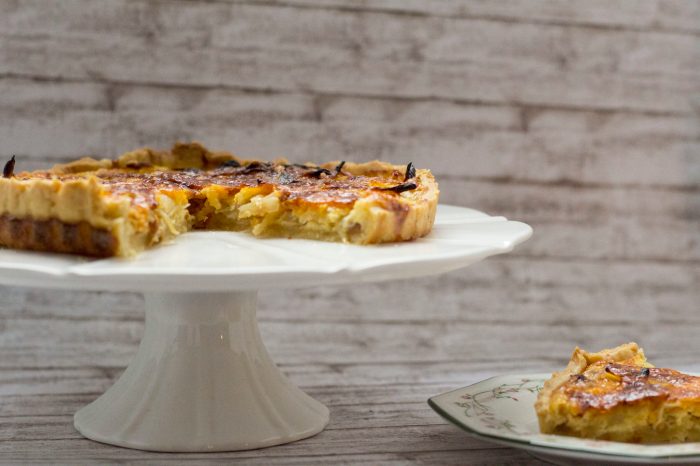
Zwiebelkuchen, the beloved German onion pie, boasts a rich history interwoven with the culinary traditions of the region. Its origins can be traced back to the 18th century, with evidence suggesting it was initially enjoyed by the working class in southwestern Germany.
Cultural Significance in Germany
Zwiebelkuchen holds a special place in German culinary culture, particularly in the southwestern regions. It is often associated with festivals, celebrations, and social gatherings. The pie’s popularity extends beyond its delectable flavor, reflecting its deep-rooted connection to the region’s history and traditions.
Regional Variations
While Zwiebelkuchen is a beloved dish across Germany, regional variations exist, primarily in the type of dough and the preparation of the onions. In the Palatinate region, the pie features a thin, crispy crust made with yeast dough, while in the Swabian region, a thicker, richer crust is preferred.
The caramelized onions are the heart of the Zwiebelkuchen, and their preparation varies from region to region. Some recipes call for the onions to be sautéed in butter or lard, while others use a combination of both.
The preparation of the onions also differs, with some recipes calling for them to be thinly sliced and caramelized slowly over low heat, while others prefer a quicker method using higher heat. These regional variations add to the charm and diversity of this traditional German dish.
Ingredients and Preparation
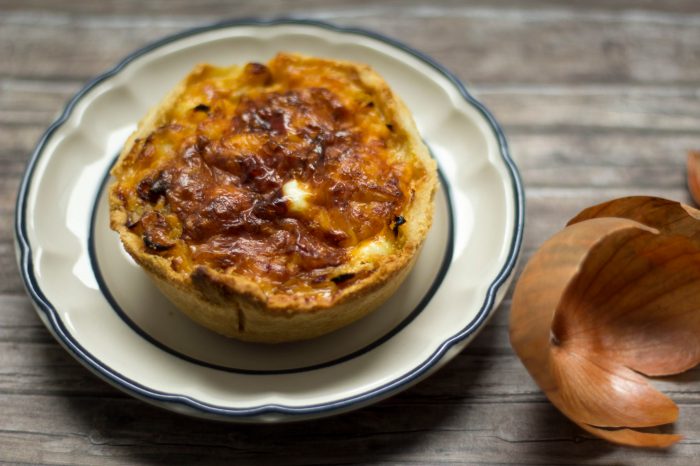
Zwiebelkuchen, the iconic German onion pie, is a culinary masterpiece that showcases the simple yet exquisite flavors of caramelized onions and a flaky, buttery crust. This beloved dish is a testament to the culinary artistry of the German people, where tradition and taste intertwine seamlessly.
The ingredients for Zwiebelkuchen are straightforward, but the preparation demands meticulous attention to detail to achieve its signature caramelized sweetness and delightful texture.
German Zwiebelkuchen, or onion pie, is a savory delight that always brings a smile to my face. The sweet and savory flavors of caramelized onions and a crispy crust are simply irresistible. Speaking of savory, I recently discovered a fantastic recipe for gluten free thanksgiving stuffing that I can’t wait to try.
The combination of herbs and spices in the stuffing reminded me of the warm, comforting flavors of Zwiebelkuchen, making me crave a slice even more!
The Essential Ingredients
The foundation of Zwiebelkuchen lies in the quality of its ingredients. The selection of each component plays a crucial role in creating a harmonious balance of flavors and textures.
- Onions:The star of the show is undoubtedly the onion. Traditionally, German yellow onions are favored for their sweet and robust flavor. The onions are thinly sliced and caramelized to perfection, resulting in a rich, caramelized sweetness that contrasts beautifully with the savory dough.
German Zwiebelkuchen, with its sweet and savory combination of onions, bacon, and dough, is a delightful treat. While it’s a far cry from the layered goodness of a chicken cordon bleu lasagna , both dishes share a common thread of comfort food that warms the soul.
Perhaps the next time I’m craving a hearty meal, I’ll try incorporating some of the flavors of Zwiebelkuchen into a lasagna creation for a unique twist.
- Dough:The dough for Zwiebelkuchen is typically a simple yeast dough, similar to that used for bread. It is enriched with butter and eggs, contributing to its flakiness and richness. The dough is rolled out thinly and forms the base for the caramelized onions.
German Zwiebelkuchen onion pie is a savory delight, with its caramelized onions and rich crust. It’s a perfect comfort food, especially when paired with a warm bowl of soup, like this chicken wild rice soup I found online. The creamy soup with its hearty rice and tender chicken is a perfect contrast to the sweetness of the onions in the Zwiebelkuchen, creating a delicious and satisfying meal.
- Seasonings:The onions are typically seasoned with salt, pepper, and a touch of sugar. This combination enhances the natural sweetness of the onions and balances their savory notes. Some recipes also include a sprinkle of caraway seeds, adding a subtle, earthy dimension to the flavor profile.
- Bacon:In some variations, bacon is added to the onion mixture for an extra layer of savory richness. The bacon is usually fried until crispy and then incorporated into the onions, adding a delightful textural contrast.
Preparing the Caramelized Onions
The caramelization of the onions is a crucial step in the preparation of Zwiebelkuchen. This process transforms the onions from their raw state to a sweet, golden-brown delight.
- Slicing the Onions:The onions are thinly sliced, either by hand or using a mandoline. Thin slicing ensures even caramelization and prevents the onions from becoming overly mushy.
- Caramelizing the Onions:The sliced onions are cooked over low heat in a large skillet or pot with a generous amount of butter. The onions are slowly cooked, stirring frequently, until they turn a deep golden brown. This process can take anywhere from 30 minutes to an hour, depending on the amount of onions.
The key is to cook them slowly and patiently, allowing the natural sugars in the onions to caramelize.
- Seasoning the Onions:As the onions caramelize, they are seasoned with salt, pepper, and a touch of sugar. The sugar enhances the caramelization process and balances the savory flavors.
Assembling the Zwiebelkuchen
Once the onions are caramelized, the pie is assembled.
- Preparing the Dough:The dough is rolled out thinly to fit a baking sheet or pie pan. The dough is then placed in the pan and gently pressed into the bottom and sides.
- Adding the Onions:The caramelized onions are spread evenly over the dough. If using bacon, it is added to the onions at this stage.
- Baking the Pie:The Zwiebelkuchen is baked in a preheated oven until the crust is golden brown and the onions are bubbling. The baking time will vary depending on the size of the pie and the oven temperature.
Variations and Adaptations
The traditional Zwiebelkuchen is a testament to simplicity, but its essence has inspired countless variations, each adding its own unique twist to the classic recipe. From the addition of different toppings to innovative flavor profiles, these adaptations showcase the versatility of this beloved German dish.
Variations in Toppings, German zwiebelkuchen onion pie
Variations in toppings offer a spectrum of flavors and textures to the traditional Zwiebelkuchen. The addition of various cheeses, meats, or vegetables can elevate the dish to new heights.
- Cheese: Adding cheese to the onion mixture is a common variation. Popular choices include Emmental, Gruyère, or even goat cheese, which add a creamy richness and a sharp, tangy flavor.
- Meats: For a more substantial Zwiebelkuchen, adding bacon, sausage, or even a few slices of ham can provide a savory and smoky element. These meats are often sautéed with the onions for added depth of flavor.
- Vegetables: Other vegetables, such as mushrooms, bell peppers, or spinach, can be incorporated into the onion mixture or added as a topping. These additions introduce different textures and flavors, adding complexity to the dish.
Modern Interpretations
Modern interpretations of Zwiebelkuchen are pushing the boundaries of tradition, exploring innovative approaches to ingredients, presentation, and flavor profiles.
- Gourmet Zwiebelkuchen: Some chefs are elevating Zwiebelkuchen to a gourmet level, using high-quality ingredients and sophisticated flavor combinations. This could include using artisanal cheeses, cured meats, or even exotic spices.
- Creative Presentations: Modern chefs are also experimenting with presentation, creating visually stunning Zwiebelkuchen with intricate toppings or unique serving styles. This could involve using different shapes for the crust, layering toppings in creative ways, or even incorporating edible flowers for decoration.
- Fusion Flavors: Some modern interpretations of Zwiebelkuchen incorporate influences from other cuisines, creating unique flavor profiles. For example, a fusion Zwiebelkuchen might include Asian-inspired ingredients like ginger, soy sauce, or sesame seeds.
Serving and Enjoyment
Zwiebelkuchen is not merely a dish; it’s an experience that embodies the heart of German culinary tradition. The way it’s served and enjoyed reflects the cultural significance of this beloved onion pie.
Traditional Serving Methods
The traditional way to enjoy Zwiebelkuchen is simple yet satisfying. It’s often served warm, sliced into wedges, and enjoyed with a variety of accompaniments.
- A glass of Riesling:This dry white wine, with its crisp acidity, perfectly complements the savory flavors of the onion pie. The combination is a classic pairing in Germany, often enjoyed at local wine festivals and taverns.
- A cold beer:For those who prefer a more refreshing beverage, a cool glass of German beer, such as a Pilsner or Helles, is a delightful companion to Zwiebelkuchen. The light bitterness of the beer balances the sweetness of the caramelized onions.
- Apple cider:Another popular choice is apple cider, which adds a touch of sweetness and fruitiness to the meal. This combination is especially appealing in the autumn months when the apple harvest is in full swing.
- Mustard:A dollop of sweet or spicy mustard is a traditional condiment for Zwiebelkuchen. It adds a tangy note that enhances the savory flavors of the pie.
- Sour cream:A dollop of sour cream provides a creamy and tangy counterpoint to the richness of the pie.
Cultural Significance
Zwiebelkuchen holds a special place in German culture, particularly in the southwestern region of the country. It’s a staple at local festivals, known as “Zwiebelkuchenfeste,” where people gather to celebrate the harvest and enjoy the traditional pie.
“The aroma of Zwiebelkuchen baking in the oven is a familiar scent that evokes memories of childhood and family gatherings.”
A German resident
Beyond festivals, Zwiebelkuchen is also a popular dish for everyday meals. It’s often served as a light lunch or a hearty dinner, accompanied by a simple salad or a side of potato salad. The pie is also a common sight at family gatherings and celebrations, bringing people together over a shared culinary experience.
Cultural Impact and Symbolism
Zwiebelkuchen, the savory onion pie, is more than just a delicious dish in Germany. It’s deeply woven into the fabric of German culture, reflecting traditions, regional identity, and the importance of community. Its presence at gatherings and its association with particular times of the year illustrate its cultural significance.
Regional Identity and Traditions
Zwiebelkuchen is particularly cherished in the southwestern region of Germany, specifically in the Palatinate (Pfalz) and Franconia (Franken). It’s often considered a quintessential part of their culinary heritage, reflecting the local agricultural traditions and the use of readily available ingredients.
The Palatinate region, known for its vineyards, often incorporates Zwiebelkuchen into wine festivals and celebrations, further solidifying its connection to the region’s cultural identity.
Symbol of Hospitality and Community
The act of sharing Zwiebelkuchen often represents hospitality and warmth. It’s a dish that’s frequently served at social gatherings, family celebrations, and even casual get-togethers. The shared experience of enjoying this savory pie fosters a sense of community and connection.
Its presence at these occasions symbolizes the importance of togetherness and the enjoyment of simple pleasures.
Seasonal Significance
Zwiebelkuchen is particularly popular in the autumn months, coinciding with the harvest of onions and the onset of cooler weather. This seasonal association further strengthens its cultural significance. It’s often enjoyed during the “Federweißer” season, a period when young, unfiltered wine is available, creating a traditional pairing that reflects the flavors and rhythms of the autumn season.
Symbolic Meanings
The round shape of Zwiebelkuchen can be interpreted as a symbol of unity and wholeness, reflecting the interconnectedness of communities and the importance of shared experiences. The golden-brown crust and the caramelized onions can be seen as representations of warmth, abundance, and the bounty of the harvest.
Visual Representation
Zwiebelkuchen, with its golden-brown crust and caramelized onions, is a visual feast. To fully appreciate this delightful pie, it’s essential to understand the visual components that contribute to its appeal.
Ingredients and Their Roles
The key ingredients of Zwiebelkuchen play distinct visual roles in creating the pie’s unique appearance.
| Ingredient | Role |
|---|---|
| Yeast Dough | Forms the base, providing a golden-brown, slightly crusty texture. |
| Onions | Caramelized onions create a rich, brown topping, adding visual interest and depth. |
| Bacon | Adds a smoky, savory element and provides contrasting visual texture. |
| Spices | Enhance the flavor profile and contribute to the overall visual appeal. |
| Butter | Provides a glossy finish and adds richness to the crust. |
Visual Representation of Zwiebelkuchen
Imagine a circular pie, with a golden-brown, slightly crusty base. A generous layer of caramelized onions, a deep brown color with hints of golden hues, covers the crust. Scattered across the onions are small pieces of bacon, adding a smoky, savory element and a contrasting visual texture.
The overall effect is a visually appealing pie, with a rustic charm and a comforting aroma.

